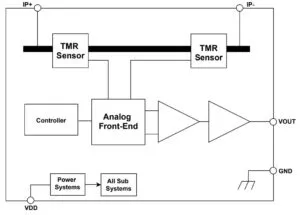Implemented in its CT4022 and CT4032 sensors, the company claims 2.8mArms typical noise when the devices are powered with 5V, and 3.6mArms when the supply rail is 3.3V (lowest noise variant, 25°C, 100kHz BW, 0A).
“They achieve a 2x reduction in rms noise versus previous TMR solutions, and a 4x reduction compared to Hall-based integrated conductor solutions,” claimed Allegro business director Matt Hein.
Packaging is the difference between the two part numbers:
- CT4022 comes in standard 8pin SOIC
- CT4032 is a wide-body 16pin SOIC
The 8pin SOIC has a 1mΩ 1.7nH current path and is rated for 560Vrms basic or 280Vrms reinforced isolation, and 3.5kVrms for one minute (UL 62368-1 3rd edition), with 4mm creepage and clearance.
At the expense of its higher inductance (1mΩ, 5nH), the wide 16pin SOIC increases those isolation values to 1,097Vrms basic, 565Vrms reinforced and 5kVrms for one minute, with 8mm creepage and clearance.
Five different variants cover five current ranges: ±12, 24, 40, 50 or 65A. Gains differ between the parts and the analogue outputs are ratiometric with supply voltage – centrered around Vcc/2 = 0A. Max current is 150A.
There is no reference output for the zero point. Instead this point will be within ±20mV of Vcc/2 over the full -40 to +125°C operating, and better in some parts.
Automotive versions (AEC-Q100 Grade 1) of all five are available in both packages, while the five industrial version are restricted to the narrow SOIC.
Find the current sensors on this Allegro product page
For non-isolated automotive current sensing, Rohm introduced some shunt amplifiers that work with either voltage rail in June

